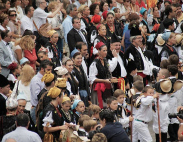
Fiesta de San Roque
Like the majority of Spain’s fiestas, the Fiesta of San Roque celebrates the life of an important Catholic saint. San Roque is the Spanish name for Saint Roch, who was born in Montpellier, France in the 13th century. His family were well positioned within the city, his father holding the position of governor.
The traditional story of San Roque tells that he was born with a cross shaped birthmark on his chest, which was considered a mark of God. At the age of 20, Roque’s parent’s died, leaving him an orphan. Instead of taking on his father’s position as he was entitled to, he gave up all his wealth and began a pilgrimage to Rome. During his journey, Roque came upon villages where plague was rife. Instead of escaping as quickly as possible, Roque performed miracles, curing the sick. It is said that Roque finally contracted the plague himself, and wandered into the forest to die. As he lay there, a dog appeared, and helped him to recover by stealing food. It is for this reason that San Roque is known as the saint of dogs, and statues of him often include a dog at his feet. Roque later returned to Montpellier, where he was arrested as a spy and died in prison.
The so-called cult of San Roque began to grow after his death, from its origins in Italy and France to Spain, Lebanon and Germany. Over the centuries, his name was often invoked during plagues and was eventually canonized by Pope Gregory XIV, the saint’s official day being named as August 16th.
The Fiesta de San Roque is marked in towns throughout most provinces in Spain and his day is celebrated with typical Spanish style. The serious side of the day starts with a Catholic mass and procession through the streets. Many people remember San Roque’s pilgrimage to Rome by participating in La Romeria, a walk to a nearby hermitage or other locality of religious significance. As with most Spanish feast days and holidays, the religious element is complemented with fun with some towns holding historical re-enactments, fireworks and even large scale water fights.
While the Fiesta de San Roque may not be internationally recognised in the same way as La Tomatina or he Pamplona bull run, those who participate in it do so with equal enthusiasm, making this more than just another party, and well worth seeing if you want a glimpse into Spain’s traditional culture.
 Follow
Follow



